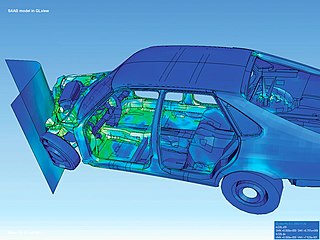This article's factual accuracy is disputed .(October 2009) |
In computational electromagnetics, the scattering-matrix method (SMM) is a numerical method used to solve Maxwell's equations, [1] related to the transfer-matrix method.
This article's factual accuracy is disputed .(October 2009) |
In computational electromagnetics, the scattering-matrix method (SMM) is a numerical method used to solve Maxwell's equations, [1] related to the transfer-matrix method.
SMM can, for example, use cylinders to model dielectric/metal objects in the domain. [2] The total-field/scattered-field (TF/SF) formalism where the total field is written as sum of incident and scattered at each point in the domain:
By assuming series solutions for the total field, the SMM method transforms the domain into a cylindrical problem. In this domain total field is written in terms of Bessel and Hankel function solutions to the cylindrical Helmholtz equation. SMM method formulation, finally helps compute these coefficients of the cylindrical harmonic functions within the cylinder and outside it, at the same time satisfying EM boundary conditions.
Finally, SMM accuracy can be increased by adding (removing) cylindrical harmonic terms used to model the scattered fields.
SMM, eventually leads to a matrix formalism, and the coefficients are calculated through matrix inversion. For N-cylinders, each scattered field modeled using 2M+1 harmonic terms, SMM requires to solve a N(2M + 1) system of equations.
SMM, is a rigorous and accurate method deriving from first principles. Hence, it is guaranteed to be accurate within limits of model, and not show spurious effects of numerical dispersion arising in other techniques like Finite-difference time-domain (FDTD) method.

Maxwell's equations, or Maxwell–Heaviside equations, are a set of coupled partial differential equations that, together with the Lorentz force law, form the foundation of classical electromagnetism, classical optics, and electric circuits. The equations provide a mathematical model for electric, optical, and radio technologies, such as power generation, electric motors, wireless communication, lenses, radar etc. They describe how electric and magnetic fields are generated by charges, currents, and changes of the fields. The equations are named after the physicist and mathematician James Clerk Maxwell, who, in 1861 and 1862, published an early form of the equations that included the Lorentz force law. Maxwell first used the equations to propose that light is an electromagnetic phenomenon. The modern form of the equations in their most common formulation is credited to Oliver Heaviside.

In mathematics, a partial differential equation (PDE) is an equation which computes a function between various partial derivatives of a multivariable function.

Scattering is a term used in physics to describe a wide range of physical processes where moving particles or radiation of some form, such as light or sound, are forced to deviate from a straight trajectory by localized non-uniformities in the medium through which they pass. In conventional use, this also includes deviation of reflected radiation from the angle predicted by the law of reflection. Reflections of radiation that undergo scattering are often called diffuse reflections and unscattered reflections are called specular (mirror-like) reflections. Originally, the term was confined to light scattering. As more "ray"-like phenomena were discovered, the idea of scattering was extended to them, so that William Herschel could refer to the scattering of "heat rays" in 1800. John Tyndall, a pioneer in light scattering research, noted the connection between light scattering and acoustic scattering in the 1870s. Near the end of the 19th century, the scattering of cathode rays and X-rays was observed and discussed. With the discovery of subatomic particles and the development of quantum theory in the 20th century, the sense of the term became broader as it was recognized that the same mathematical frameworks used in light scattering could be applied to many other phenomena.
Numerical methods for partial differential equations is the branch of numerical analysis that studies the numerical solution of partial differential equations (PDEs).
The boundary element method (BEM) is a numerical computational method of solving linear partial differential equations which have been formulated as integral equations, including fluid mechanics, acoustics, electromagnetics, fracture mechanics, and contact mechanics.

Finite-difference time-domain (FDTD) or Yee's method is a numerical analysis technique used for modeling computational electrodynamics. Since it is a time-domain method, FDTD solutions can cover a wide frequency range with a single simulation run, and treat nonlinear material properties in a natural way.

Computational electromagnetics (CEM), computational electrodynamics or electromagnetic modeling is the process of modeling the interaction of electromagnetic fields with physical objects and the environment.
Electromagnetic field solvers are specialized programs that solve Maxwell's equations directly. They form a part of the field of electronic design automation, or EDA, and are commonly used in the design of integrated circuits and printed circuit boards. They are used when a solution from first principles is needed, or the highest accuracy is required.
The finite-difference frequency-domain (FDFD) method is a numerical solution method for problems usually in electromagnetism and sometimes in acoustics, based on finite-difference approximations of the derivative operators in the differential equation being solved.
The beam propagation method (BPM) is an approximation technique for simulating the propagation of light in slowly varying optical waveguides. It is essentially the same as the so-called parabolic equation (PE) method in underwater acoustics. Both BPM and the PE were first introduced in the 1970s. When a wave propagates along a waveguide for a large distance, rigorous numerical simulation is difficult. The BPM relies on approximate differential equations which are also called the one-way models. These one-way models involve only a first order derivative in the variable z and they can be solved as "initial" value problem. The "initial" value problem does not involve time, rather it is for the spatial variable z.
Light scattering by particles is the process by which small particles scatter light causing optical phenomena such as the blue color of the sky, and halos.
Plane wave expansion method (PWE) refers to a computational technique in electromagnetics to solve the Maxwell's equations by formulating an eigenvalue problem out of the equation. This method is popular among the photonic crystal community as a method of solving for the band structure of specific photonic crystal geometries. PWE is traceable to the analytical formulations, and is useful in calculating modal solutions of Maxwell's equations over an inhomogeneous or periodic geometry. It is specifically tuned to solve problems in a time-harmonic forms, with non-dispersive media.

The finite element method (FEM) is a popular method for numerically solving differential equations arising in engineering and mathematical modeling. Typical problem areas of interest include the traditional fields of structural analysis, heat transfer, fluid flow, mass transport, and electromagnetic potential.
Eigenmode expansion (EME) is a computational electrodynamics modelling technique. It is also referred to as the mode matching technique or the bidirectional eigenmode propagation method. Eigenmode expansion is a linear frequency-domain method.
Rigorous coupled-wave analysis (RCWA) is a semi-analytical method in computational electromagnetics that is most typically applied to solve scattering from periodic dielectric structures. It is a Fourier-space method so devices and fields are represented as a sum of spatial harmonics.

High-order compact finite difference schemes are used for solving third-order differential equations created during the study of obstacle boundary value problems. They have been shown to be highly accurate and efficient. They are constructed by modifying the second-order scheme that was developed by Noor and Al-Said in 2002. The convergence rate of the high-order compact scheme is third order, the second-order scheme is fourth order.

A frequency-selective surface (FSS) is any thin, repetitive surface designed to reflect, transmit or absorb electromagnetic fields based on the frequency of the field. In this sense, an FSS is a type of optical filter or metal-mesh optical filters in which the filtering is accomplished by virtue of the regular, periodic pattern on the surface of the FSS. Though not explicitly mentioned in the name, FSS's also have properties which vary with incidence angle and polarization as well - these are unavoidable consequences of the way in which FSS's are constructed. Frequency-selective surfaces have been most commonly used in the radio frequency region of the electromagnetic spectrum and find use in applications as diverse as the aforementioned microwave oven, antenna radomes and modern metamaterials. Sometimes frequency selective surfaces are referred to simply as periodic surfaces and are a 2-dimensional analog of the new periodic volumes known as photonic crystals.
Kane Shee-Gong Yee is a Chinese-American electrical engineer and mathematician. He is best known for introducing the finite-difference time-domain method (FDTD) in 1966.

The method of moments (MoM), also known as the moment method and method of weighted residuals, is a numerical method in computational electromagnetics. It is used in computer programs that simulate the interaction of electromagnetic fields such as radio waves with matter, for example antenna simulation programs like NEC that calculate the radiation pattern of an antenna. Generally being a frequency-domain method, it involves the projection of an integral equation into a system of linear equations by the application of appropriate boundary conditions. This is done by using discrete meshes as in finite difference and finite element methods, often for the surface. The solutions are represented with the linear combination of pre-defined basis functions; generally, the coefficients of these basis functions are the sought unknowns. Green's functions and Galerkin method play a central role in the method of moments.